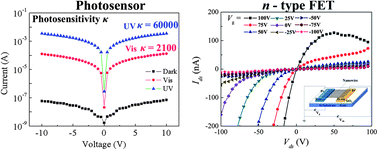Ultrasensitive visible light photoresponse and electrical transportation properties of nonstoichiometric indium oxide nanowire arrays by electrospinning
Abstract
We report on the below-bandgap photoresponse and electrical properties of In2O3 nanowires fabricated by a low-cost electrospinning technique. The as-prepared In2O3 nanowires show ultra-high sensitivity up to 103 to 104 with a much broadened response spectrum which is extended to the visible region. The dramatically enhanced photoconduction under below-bandgap light illumination is attributed to the transition from defect levels, which are introduced by oxygen vacancies present in the nonstoichiometric In2O2.68 nanowires. The underlying mechanism is further clarified by the UV-vis absorption and photoluminescence spectra, where an obvious red shift in the absorption edge and a remarkable emission peak covering the visible region are detected. Moreover, electrical characterizations of bottom-up-assembled field effect transistors (FETs) confirm the intrinsic n-type semiconducting behavior with an increased electron concentration, strongly indicating the formation of donor levels which induce the below-bandgap photoresponse. The concept of realizing dual-band photodetection in a single semiconductor system holds great promise in the fields of energy conversion, fire/flame detection and other military applications.


 Please wait while we load your content...
Please wait while we load your content...